Jigging speckled trout is hands down the best way to catch a limit across Louisiana's coast. If you can master this tackle and technique then you will be a far more formidable angler.
In this guide, you will learn everything you need to know to select the best jigging rod, reel, fishing line and lures, as well as how to use them in order to catch speckled trout (as well as other species) wherever they swim.
!WARNING!
There is a lot to learn here, but if you can get through this guide you will have an edge other anglers do not.
Trust me, what you find here is what will empower you to catch speckled trout in places you have not been able to catch them before.
What I am going to show you here is what I have used for years in places like Lake Pontchartrain's bridges, natural gas platforms in open water, rock piles and more in locations everywhere from Slidell to Venice to Vermillion Bay and beyond.
This is a detailed guide. You will have to read and apply yourself. If you have questions then please use the comments section at the very bottom.
But, if you're looking for shortcuts that don't work, then there's plenty of 22 year old kids on TikTok posting dumbass videos every day.
You can have a quick laugh or you can learn something legit. The choice is yours.
So, with that "warning" out of the way, let's begin this guide by taking a look at what exactly jigging tackle for speckled trout is.
It's important that we are on the same sheet of music.
What exactly is the tackle used for jigging speckled trout?
The term "jigging" is not exclusive to speckled trout fishing in Louisiana. It can be used to describe a bunch of other techniques used outside the realm of inshore fishing.
So it's very important to be clear as to what I am referring to.
That's because you would probably buy the wrong rod or reel if you only read the headline to this guide and took off to go online shopping without having a good handle on what tackle for jigging speckled trout actually is.
So what I am referring to here is:
If you've read my guides and watched my videos over the years, then you have definitely seen this tackle in action catching speckled trout and slot redfish across Louisiana's coast.
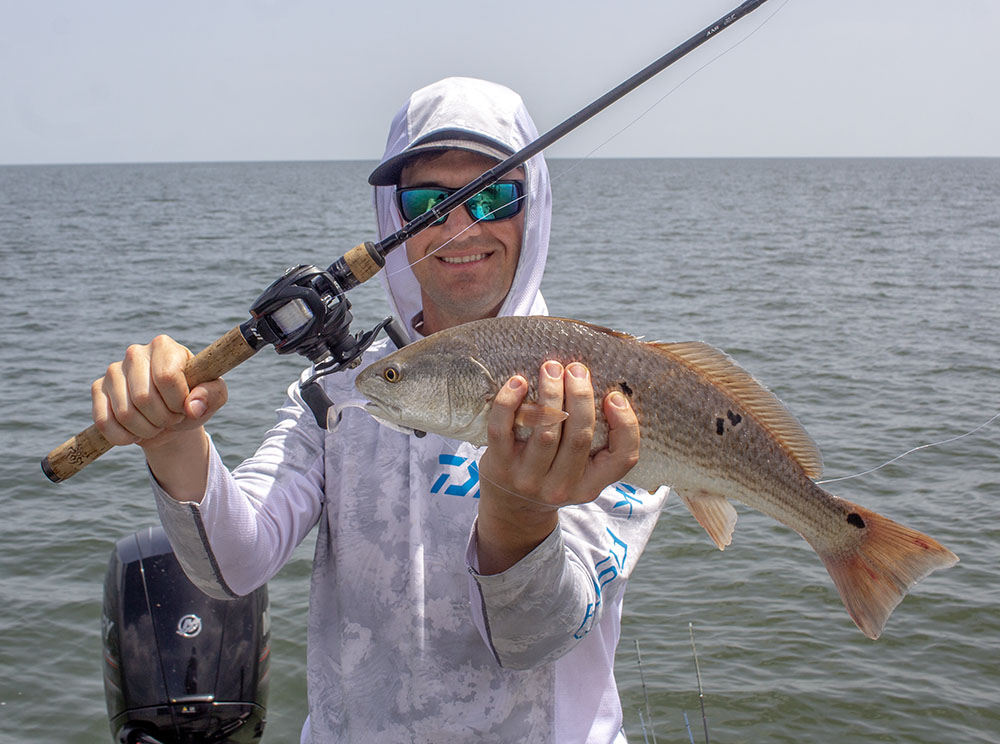
What you see here is Daiwa Tatula 100, Daiwa 6'4" medium-fast casting rod and 14lb monofilament fishing line. Used to jig slot redfish in Lake Pontchartrain.
I've fished many variations of this tackle over the years. If you look closely at the content I've produced you will see a litany of different brands ranging from Abu Garcia, to Duce, to Lew's, to Shimano to Daiwa.
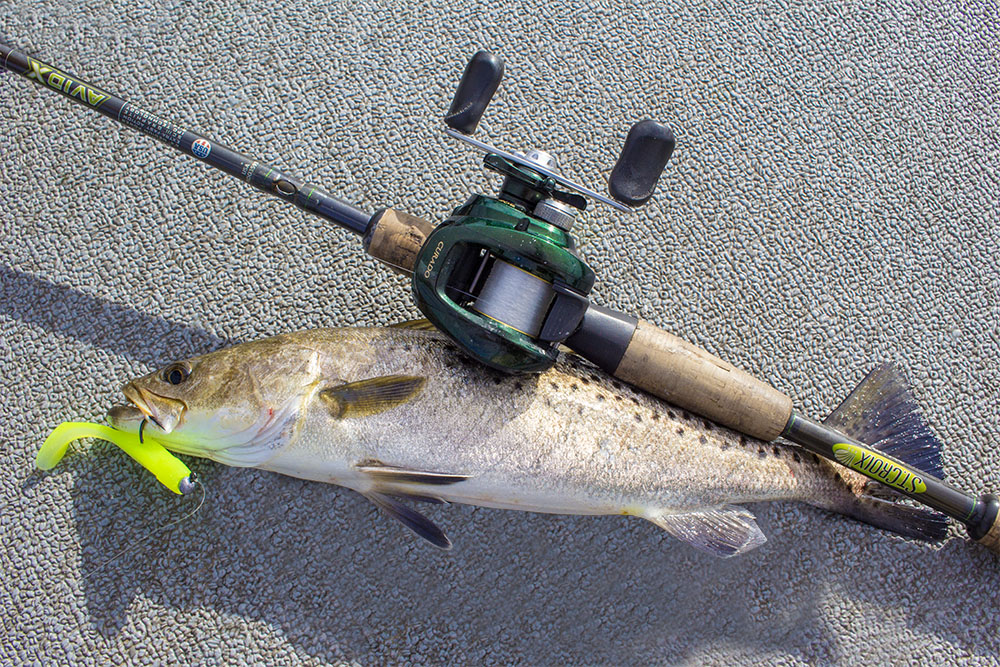
As you can see, this is a completely different setup from the Daiwa combo above. This is a Shimano Curado 50e spooled in 12lb monofilament on a St. Croix medium-extra fast 6'4" casting rod. Both are no longer in production.
So why am I using different brands? Is it because one is better than the other?
No.
I've used different brands over the years because I like trying new tackle, or maybe I got a meager promotional deal (i.e. free rods and reels), etc.
Whatever the case, I always fished with tackle I liked and thought was best to seal the deal on my fishing goals, which is usually catching a limit of speckled trout and/or redfish.
Those experiences taught me that what matters most is not one particular brand over another, but knowing what specifications to choose.
If you can do that, then you can shop virtually anywhere and come away with a good deal on casting tackle that will be great for jigging speckled trout.
So, those exact fishing rod and reel specifications are what you and I are looking at in this guide.
Let's begin with the casting rod:
The Best Casting Rod For Jigging Speckled Trout
You need to be jigging with a rod no longer than 6' 6", with a medium-light or medium power and extra-fast or fast action.
The lighter power is fitting for speckled trout, and the fast tip is great for taking up slack!
Plus, the shorter the rod, the lighter it weighs, and the easier it is on your hand and arm.
Most of the rods I use for jigging speckled trout are 6' 2" to 6'4".
Rods this short are a niche application and few anglers buy them, so they can be harder to come by.
However, several companies do make them:
- St. Croix Avid-X AXC64MXF (6' 4" Medium X-Fast)
- Daiwa Tatula TTU631 (6'3" Medium Fast)
- Abu Garcia Vendetta VDTIIC63-5 (6'3" Medium Fast)
I'm sure there are others out there, and you will have to look for them. However, the three above are a great start.
You wouldn't want to use a longer, heavier rod because it would be too bulky and heavy for the kind of jigging technique described later in this guide.
For example, the 7'3", heavy power, moderate slow action rod pictured below is made for large power baits and I would never dream of using it for jigging speckled trout.
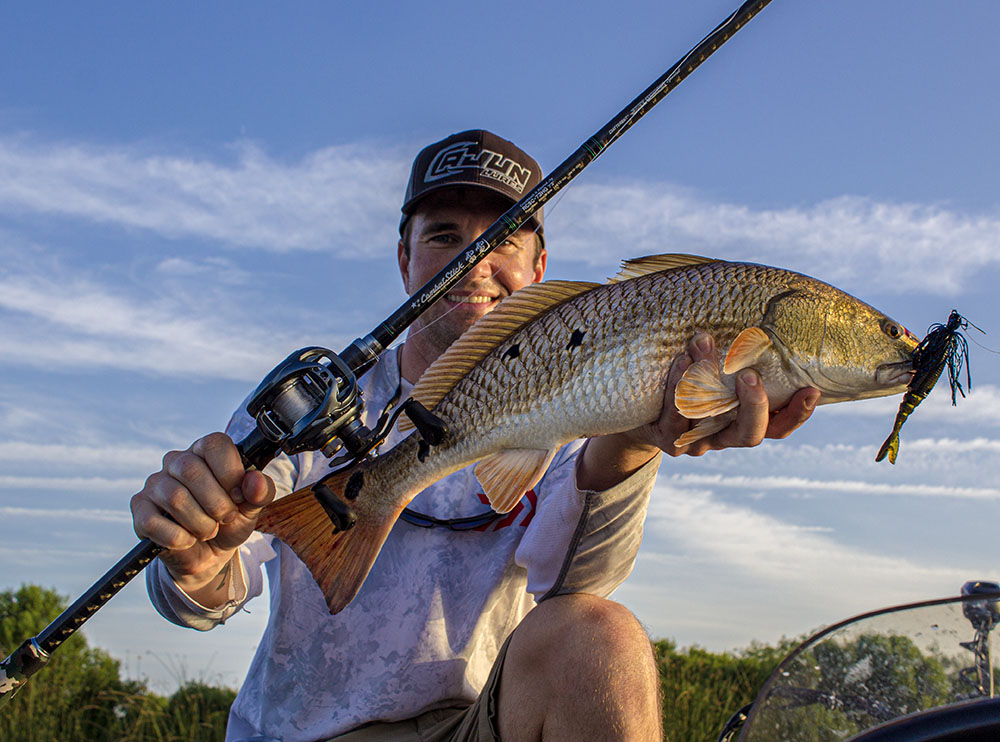
A rod, reel and line combination like this one is just too much for jigging speckled trout. There's no advantage to using tackle this powerful for jigging, only disadvantage.
It will make sense once you take a closer look at it and eventually do it yourself.
Next, let's look at casting reels:
The Best Casting Reel For Jigging Speckled Trout
The best tackle for jigging speckled trout includes a good casting reel, something with these features:
A good example would be a Daiwa Tatula 80. A bad example would be an Abu Garcia Revo Inshore, which is a big and heavy reel.
You don't need a lot of fishing line for this technique, nor do you need cranking power.
You want something that's small, lightweight and easily fits in the palm of your hand. Rounded curves are better than sharper ones.
Casting reels that are under size 100 are a good choice.
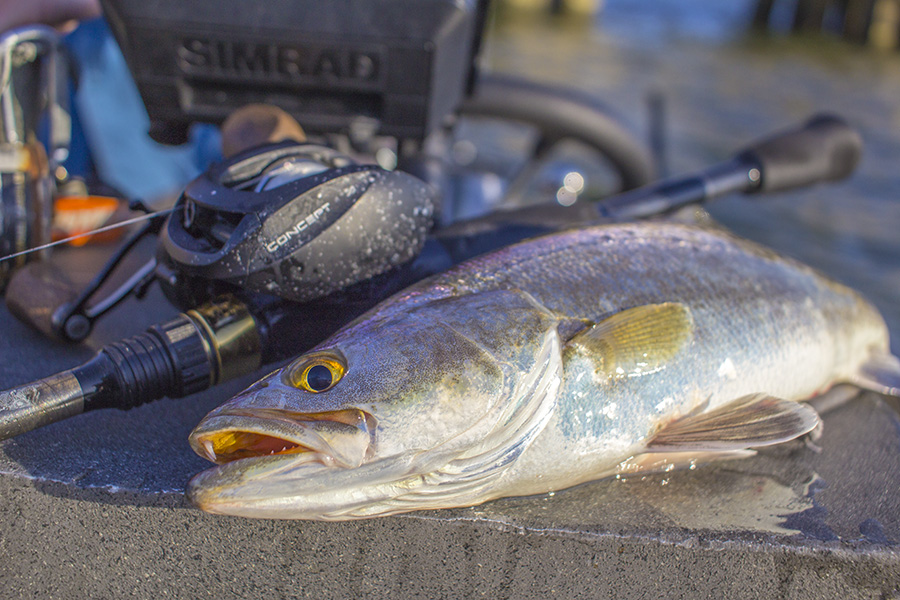
The harsh corners of the 13 Fishing Concept A were not very comfortable in my hand. However, everyone is different and you should do what works for you.
In the past I have jigged the 13 Fishing Concept A and Concept C a bunch, but with time and experience have discovered the Daiwa Tatula 80 to be a better choice.
This reel comes with a lightning fast 8.1:1 gear ratio, reeling in 34 inches per turn of the handle.
For what it's worth, I've also had great experiences with the Shimano Curado and Lew's Tournament Pro G.
At the end of the day, look for the specifications mentioned here to make good purchase decisions.
Huh? Rod & Reel Specs Not Making Sense?
If you made it this far in the guide, then congratulations and thank you.
Attention spans are short these days and it says a lot about your passion for inshore fishing if you can get through long-form content like the guide you're reading now.
So, you've probably read the specifications for rods and reels that I've mentioned here, such as "medium-fast", "gear ratios", etc.
If these don't make sense to you, or if you're not 100% savvy on what they mean, then I strongly suggest visiting these two other guides:
Learn what's in those guides and you'll be standing head-and-shoulders above the rest of the inshore fishing crowd.
Now that we have rods and reels out of the way, let's look at what fishing line you want to spool them up with:
Fishing Line For Jigging Speckled Trout
As you're probably aware, the big three of fishing line are:
- monofilament
- fluorocarbon
- and braid
I understand that braid is widely popular amongst inshore anglers, but experience has shown me that monofilament is best for jigging speckled trout.
This is because it pairs well with the fast or extra fast action you will be using on your jigging rod. Actions that fast aren't very forgiving, and monofilament fishing line helps balance that.
That and monofilament keeps fish pinned better than braid because it stretches. Braid doesn't stretch, and that has its advantages!
But one disadvantage of braid not stretching is that it is easy to knock slack in it, making it easier for fish to spit the hook.
Just like baitcasting and spinning tackle, one line isn't better than the other when it comes to the best tackle for jigging speckled trout.
All three have different characteristics and therefore different applications.
In this application of jigging speckled trout, monofilament is the best.
But Don't Discount Fluorocarbon Just Yet
Monofilament and fluorocarbon have different characteristics that influence a jig to move differently through the water.
Monofilament is neutral buoyant, being less prone to sinking into snags and getting hung up.
Fluorocarbon is heavier, causing your jig to track closer to the bottom of the water column.
Of course, it's transparent underwater and therefore a good choice if fish are pressured or the water is very clear.
Line Diameter
I've found myself using everything from ten to fifteen pound test, mono or fluoro.
Obviously, stronger line is more forgiving with larger fish and abrasive snags, but lighter line imparts more action unto the jig, making it a good choice when the fish are being finicky.
Trust me, you will get by just fine with 10 to 15 pound test fishing line, even for accidental big redfish and drum (remember we are using this tackle to target speckled trout).
Overall, 15lb monofilament fishing line is your best choice.
It's cheap, readily had anywhere tackle is sold and, above all, it plain catches fish.
Why do we use this specific kind of casting tackle for jigging speckled trout? Why not spinning tackle?
Because a casting combo offers you more power and control over the lure than what you could achieve with spinning tackle.
It's more accurate, it's faster, it's lighter and far more responsive.
Casting tackle, combined with the knowledge and skills taught below, enables you to give enticing presentations to speckled trout in a way that spinning tackle cannot.
I could go on a rant about this, but this guide is already thousands of words long. I'd rather just get on with what you really need to know.
Or you can reinvent everything I learned in the last 15 years. It's up to you.
Anyway, moving on:
We've covered the rod, reel and fishing line you need, but what lure should you tie on?
Let's look at the fishing lures you want to use for jigging speckled trout:
The Best Lures For Jigging Speckled Trout
Jigging for speckled trout requires lures with a specific design to allow the technique to work, and must posses these qualities:
- must sink in the water column
- must be streamlined
- must have a single exposed hook
A good example of such a lure would be a 3" soft plastic rigged onto a lead jighead, like what's hanging out of this trout's mouth:
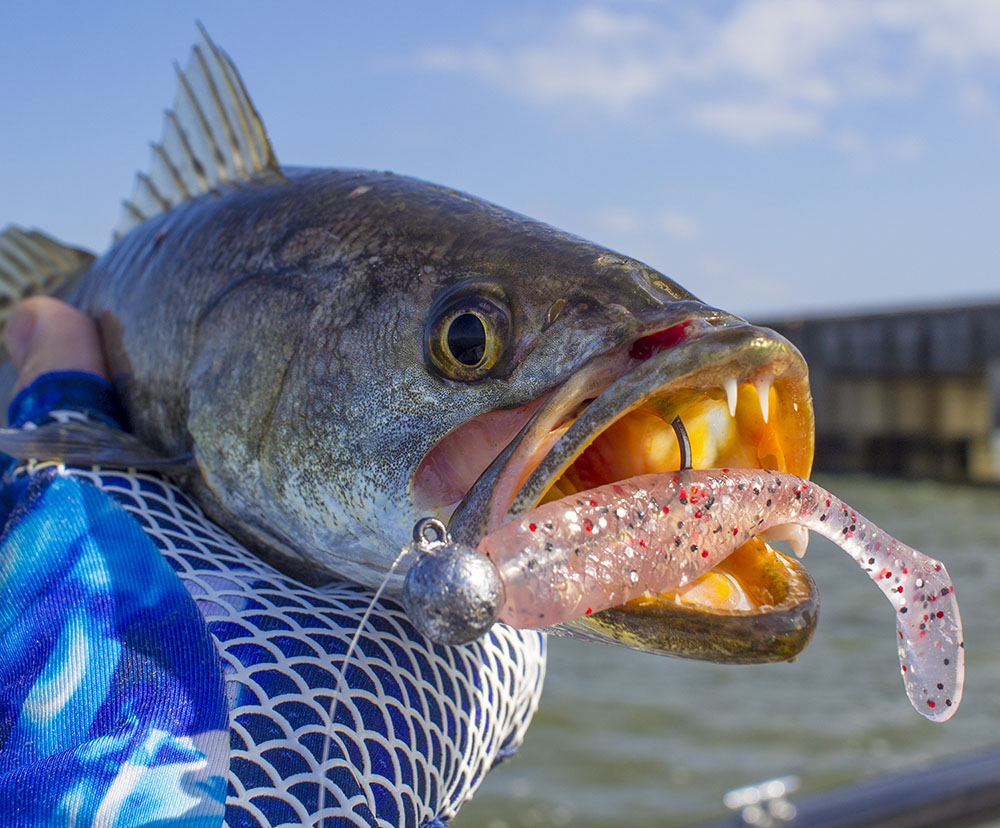
This speckled trout fell for a Matrix Shad in Shrimp Creole on a 3/8oz jighead.
Just for fun, bad examples include, but are not limited to:
- spinnerbaits (too much surface area for current to grab)
- gold spoons (again, too much surface area)
- crankbaits (won't dive until you start retrieving)
Believe me, if you find a red-hot bite, you can get speckled trout to bite anything, even deep diving crankbaits.
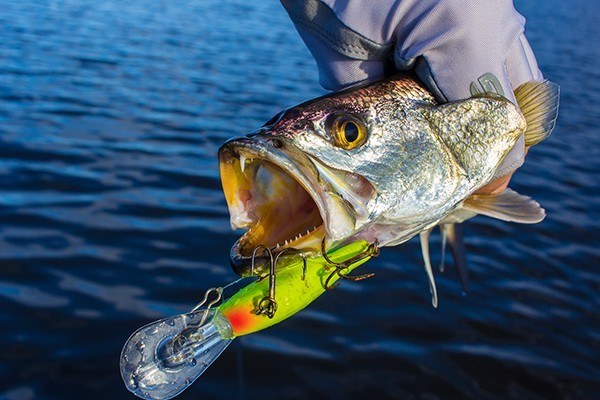
This was one of those 100+ trout days. There were just biting and that's all there was to it.
But they really prefer a jighead with a soft plastic rigged onto it, like what you see below:
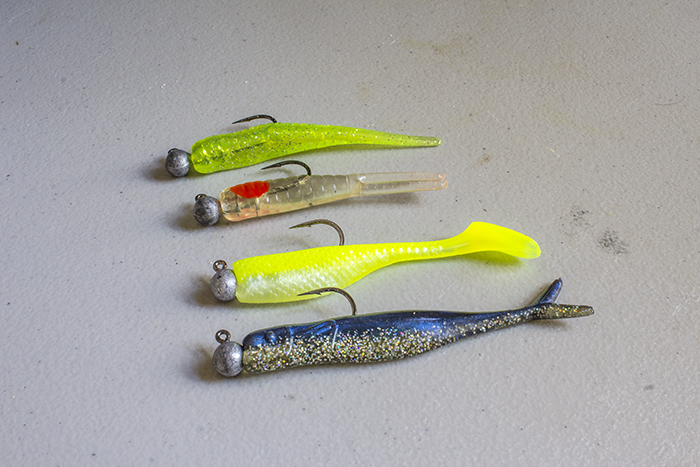
These match all of the qualities mentioned earlier.
They will sink fast in the water column, without blades or skirts to slow their descent.
Soft Plastics
A long time favorite of mine has been Matrix Shad.
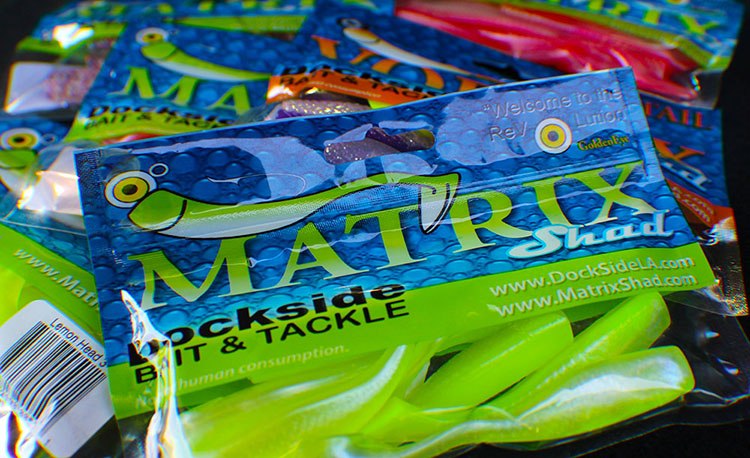
That's mostly because they are a well-made soft plastic designed for jigging speckled trout, they come in all the colors you need, and are produced by a local Louisiana company.
At the end of the day they just plain catch fish, but I do also fish with a litany of other lures to include, but not limited to:
Why bother with these different soft plastics?
While I feel that I could fish exclusively Matrix Shad for the rest of my life and be just fine, the reason I try other soft plastic lures for jigging speckled trout is because they are different in small ways that I believe could make a difference on some days.
For example, Cajun Lures soft plastics are impregnated with a strong garlic scent, whereas Slayer Inc. SST soft plastics have a larger paddle tail that changes how the jig falls through the water.
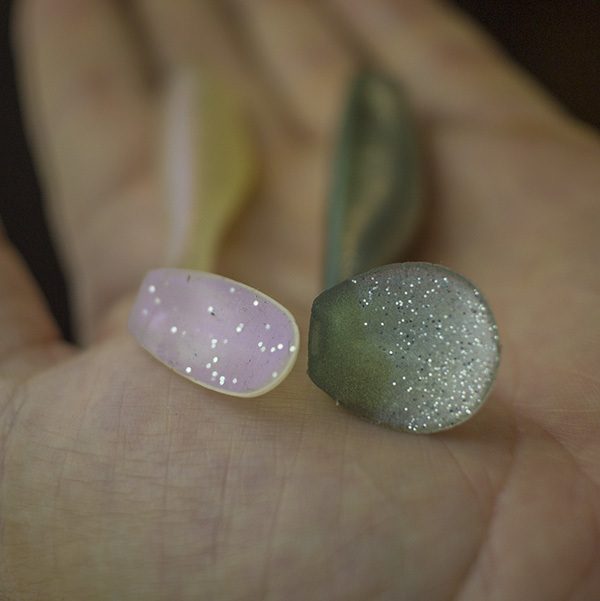
Matrix Shad on the left, Slayer Inc SST on the right. Note the difference in size and shape of the paddle tails.
It slows down the descent of the SST and gives it a wider thumping action, whereas Matrix Shad soft plastics are more subtle.
Saltwater Assassin Sea Shads are far softer and therefore have more action. They also come in a wider variety of colors that Matrix Shad does not offer.
Or maybe the speckled trout prefer something that doesn't have a paddle tail. Maybe they want something with a curly tail, like what you see below.
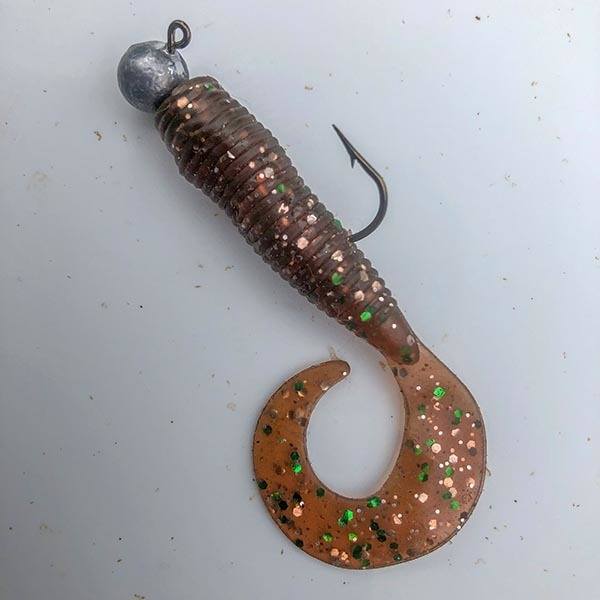
Or, maybe they want something with a straight tail, like a sparkle beetle.
Of course, sparkle beetles are just a simple "go to". They've been catching fish since 1955 and the top speckled trout in Louisiana was caught on one, so it's kind of hard to dismiss that.
Plus, they're tough and can be used for a variety of applications ranging from jigging to dropshotting to throwing a popping cork.
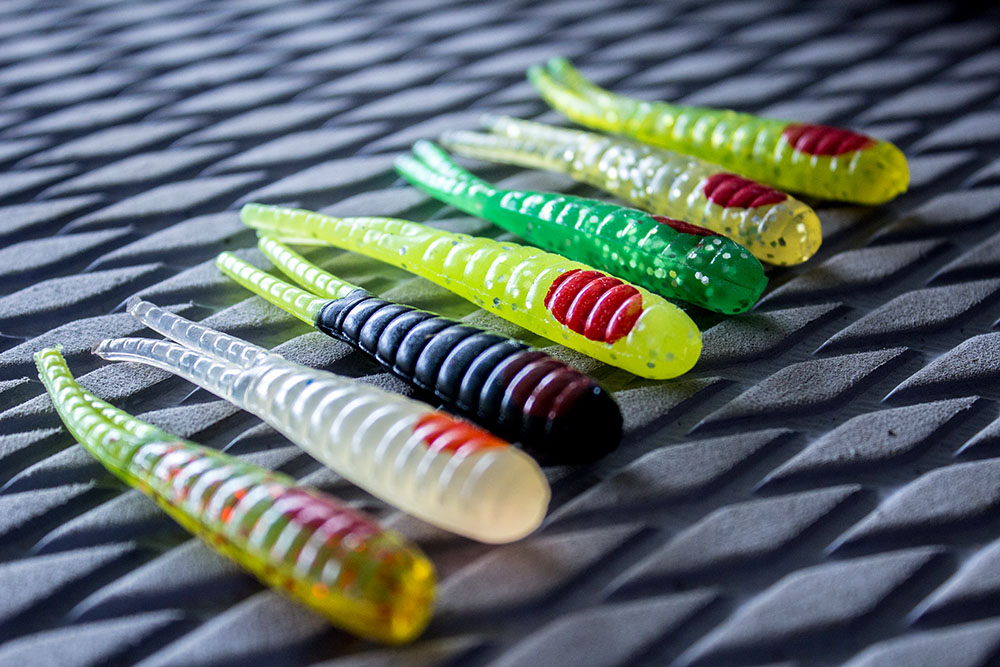
Sparkle beetles are tough, cheap and widely available. When fish aren't picky, this is my "go to".
What about lure color?
When it comes to lure color you really only need two kinds: one dark and one light, like what you see below.
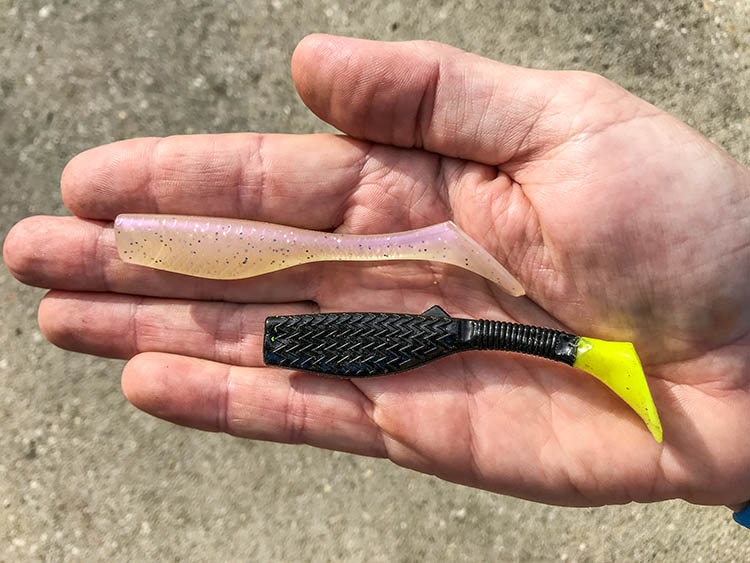
It's a general rule that you use darker colors for dirtier water, and lighter colors when it's more "trout green".
I generally begin any day of jigging speckled trout with a color like Matrix Shad's Ultraviolet, as it is my confidence color.
That's because it closely resembles the color/shine of the kinds of forage that speckled trout usually eat, whether that's menhaden, croakers or whatever.
If the water is dirty, I'll consider using a darker color that makes a rigid profile that's easier for speckled trout to see. At least, that's the theory anyway.
Or, if I see speckled trout following my jig and not committing to it, then I'll change lure color to elicit strikes. But, more often than not, I'll use a scented spray for that instead.
With all that said, there is no need for every color in the rainbow, as two things are far more important when it comes to catching speckled trout (or any fish):
- finding biting fish in the first place
- getting your lure in front of them
That's it. Don't make it harder than what it needs to be.
If you're not catching fish then those are your two problems that need solving.
It's not because you don't have live bait or don't have the right color. Trust me, you are never going to fish a spot and not catch anything on color X then put on color Y and suddenly start slaying them.
If that ever happened then it most certainly was because something else simultaneously occurred, and the color swap got the credit.
Inshore Fishing 101 Solves Those Problems
You can have the best jigging tackle and perfect technique but — if you cannot find fish to begin with — then you will never enjoy awesome fishing trips.
If you're struggling to find the fish while everyone else is posting great reports, then I strongly suggest enrolling in Inshore Fishing 101.
It's my flagship course that has helped many anglers plan successful fishing trips across Louisiana's coast:
I grew up fishing Delacroix with my dad from age 8-14. I never understood what we were doing or why, and didn’t think to ask questions. Dad did all the leg work and put us on the fish, I just threw at 'em and reeled 'em in.
Today, Captain Devin's Inshore Fishing 101 helped me learn all the things my dad knew to make those fishing trips happen. I'm able to plan good fishing trips to find 'em and catch 'em.
This is much easier due to Devin's ability to "dumb things down" and make fishing concepts easily understandable.
Now 18 years later we are getting a new boat and getting back on the water. Looking forward to showing Dad what I have learned!
I am horrible with GPS/computer interactions , so the building routes with Google was great. I can't wait to put in action to avoid shallow water and navigational hazards.
Something else I learned was fishing the entire water column, now I know what I was doing wrong and why I wasn't catching fish.
Inshore Fishing 101 is great because it is self paced, well organized and easy to navigate!
I just want to say job well done, Devin!! I think anyone who completes the course will be a more rounded angler, with more ammo in the magazine, so to speak. New angles to think about and apply to their fishing game.
I know I learned a lot, have applied it and have seen the difference that more knowledge produces! Thank you, Devin!!
Being from Texas, I can say that joining LAFB Elite — even though it's targeting Louisiana — has been worth every penny! Hell, the angler's mindset you learn there alone applies to all fishing, even freshwater bass fishing!
Inshore Fishing 101 especially has been a great tool to learn the process to finding and catching speckled trout and redfish on my own.
Inshore Fishing 101 is part of my membership: LAFB Elite.
When you join LAFB Elite you also gain instant access to the rest of my courses as well as the LAFB Elite Community.
So, with that shameless plug out of the way, my ultimate point about lure color is this: don't get lost in the black hole of buying a bunch of lures you don't need.
Just get two colors, one light and one dark, and call it a day.
Jigheads
Jigheads are just as varied as soft plastics, and it's very easy to get lost figuring out what to buy.
What you want for jigging speckled trout is something with a 90 degree shank, 3/0 hook, made of lead and some kind of modest molding to secure the soft plastic. Additionally, you want these in a range of weights going from light to heavy and you want them to be cheap.
A great example of such a jighead is the Matrix Shad Goldeneye Jighead.
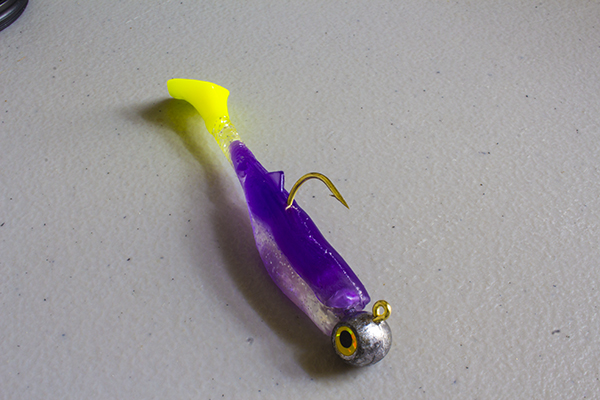
The Golden Eye jighead is a great choice.
I recommend buying these in bulk, such as their 50 pack.
If you're able to, I strongly recommend going to a local tackle store in southeast Louisiana and looking for generic, unpainted lead jigheads that are sold in bulk.
Stores like Gus's Tackle in Slidell and Chag's Sporting Goods in Metairie have these jigheads. They're well-made and great for jigging, but are also cheap.
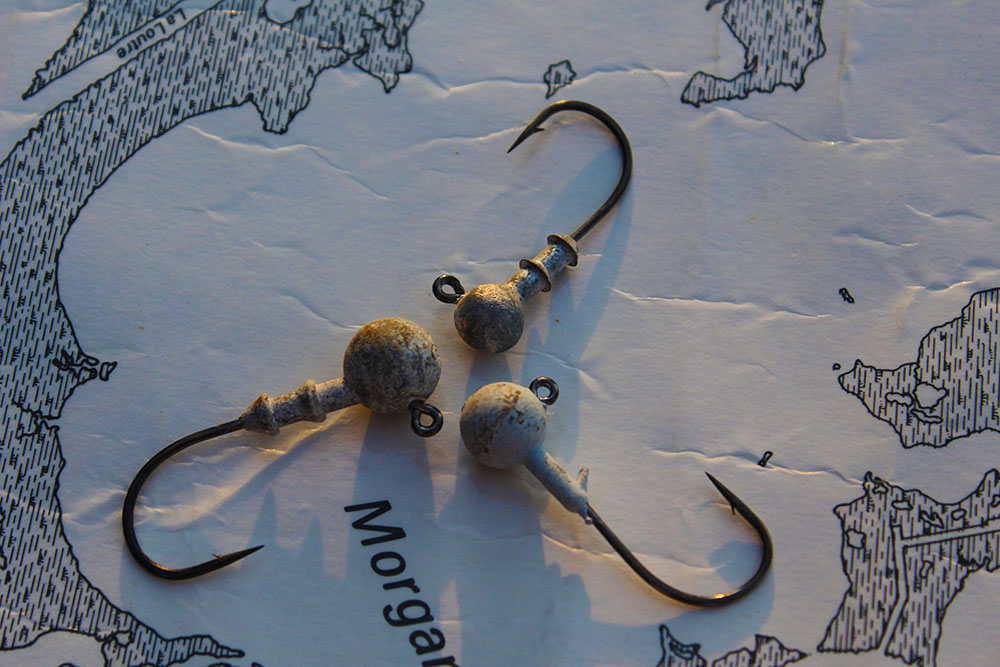
Cheap, unpainted, lead jigheads like these are a great choice as well.
What's up with using cheap jigheads?
Please don't confuse "cheap" with "poor quality". That's not the case here.
The reason you want these economically priced jigheads is because you will lose them.
Jigging speckled trout involves putting a lure at the bottom of the water column at fishing spots that tend to have a lot of snags.
You will get hung up and be unable to recover the lure. You will be forced to pop the line and, when you do, you will lose that jighead and soft plastic.
Welcome to inshore fishing. It's just part of the game.
When that inevitably happens, do you want to lose a jighead that costs cents or do you want to lose a jighead that costs dollars?
Eye or No Eye?
Some jigheads you see will feature a reflective eye to mimic the eye of an actual baitfish.
Obviously, this adds some extra "realism" to the bait, and makes it a little flashier and perhaps more likely to be noticed by a hungry speckled trout.
However, there is another reason to have the eye: fish typically eat bait head first.
The idea is that the fish will strike the lure from its front, resulting in a more complete bite of the lure that includes the hook.
While I do think there's something to this, at the end of the day what really matters is what I mentioned earlier.
Soft Plastic Retention
There does need to be some kind of molding on the shank of the hook to retain soft plastics.
If your lure gets "drooped" then it will look weird and fish will be far less likely to bite it.
Usually all you need is a barb of some sort.
There are fancier jigheads out there that have more aggressive molding to retain soft plastics, and these are great and I fish with them, but rarely do I use them for jigging speckled trout.
That's because it is difficult to quickly and easily swap out soft plastics on them. They're just too good at holding them on!
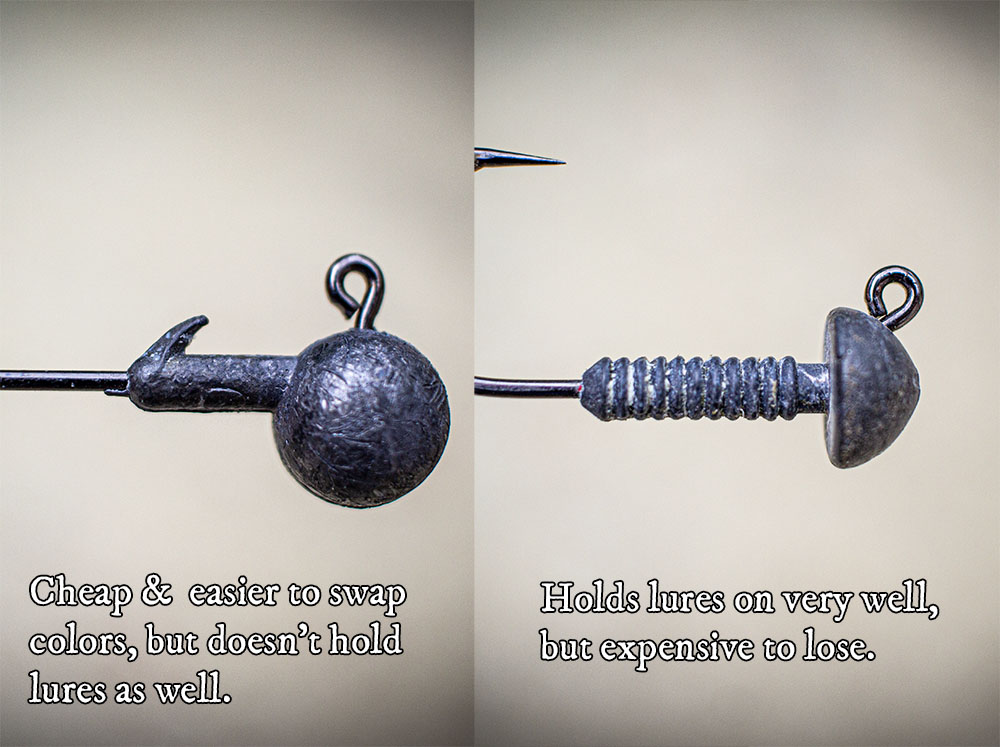
That and they're more expensive, usually costing a dollar or more. For the reason I already described above, that makes these jigheads a "no go" for my jigging setup.
But, I do like to use them for instances I don't plan on getting snagged so much, such as under a popping cork or even a Double Rig.
Properly Rigging Jigheads & Soft Plastics
Now that you now which soft plastics and jigheads to invest in, how do you put them together?
Well, the short and easy of it is that it should look like the "correct" example shown in the picture below:
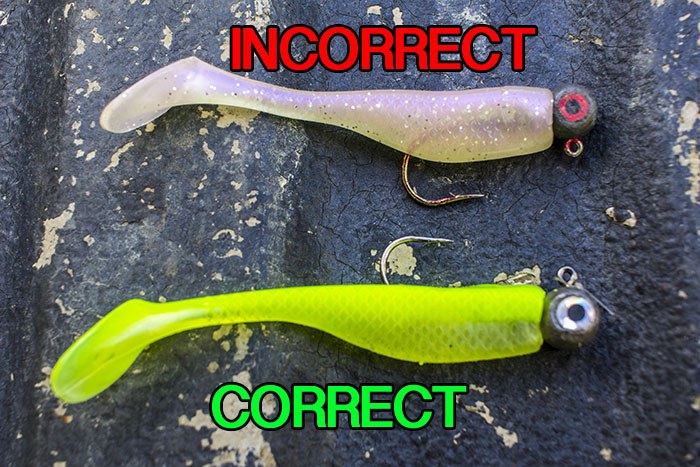
If you want more details, then you should consider all the points given in this article about rigging soft plastics.
You really want to get this right, because rigging a jighead and soft plastic correctly demonstrates you know what you are doing.
Nothing screams "I don't have a clue" more than a soft plastic rigged upside down.
Does it really matter?
Yes.
Because it makes a difference between catching and not catching.
Yes, we all know trout will hit anything during a great bite. Those fishing trips are easy.
But what about the difficult days? Correctly rigged jigheads will catch when trout are being picky.
Jighead Weights To Have Ready
Earlier I mentioned having a variety of jighead weights at hand, so let's address that in detail here.
There are a variety of conditions you will inevitably fish and you will need a variety of lighter and heavier jigheads to fish those conditions correctly.
As you'll see later in this guide, those are mainly water depth and speed.
So, you want jigheads that weigh: 1/8 oz, 1/4 oz, 3/8 oz, and 1/2 oz.
There are 3/4 oz and 1 ounce jigheads out there, but those are pretty heavy for jigging speckled trout.
The weakness of a jighead is that the weight is molded onto the hook, allowing the fish leverage to throw the hook during a head shake.
That and weights that heavy tend to fall outside the recommended lure rating for the kind of rod mentioned earlier in this guide.
While you can fish with jigheads heavier than 1/2 oz, it is recommended that — if you need heavier sinking weight — that you use a Heavy Drop Shot instead.
Moving on...
Okay, so now that we've covered rod, reel and fishing line, let's look at how to use them together, or the skills and knowledge of jigging speckled trout.
Yes, jigging is a special application that requires specific tackle, but that tackle is useless without a skilled angler employing them.
Let's get you pointed in the right direction.
Skills & Knowledge of Jigging Speckled Trout
The best way to begin understand jigging speckled trout is to know where you will use it in the first place.
This skillset is fairly universal, but it shines in some places more than others.
Where should you consider using jigging techniques for speckled trout?
Technically, you can use a jig anywhere speckled trout swim, whether the water is shallow or deep, or where there is a lot of cover, or nothing at all.
When I say "shallow", I mean 1-4ft deep and when I say "deep" I mean anything deeper than that, but usually around 10-15ft deep. I've jigged speckled trout as deep as 45ft.
Anything deeper than that, especially in heavy current, you may want to consider a heavy drop shot.
But where I usually pull out a jig is water that is about 10 to 30 feet deep.
This is because the jig is really good at giving presentations on the bottom of deeper water, it is streamlined, the best at casting accurately and offers far more power and control over such a tight package, rather than something long and clunky like a Carolina Rig.
The Best Place To Learn How To Jig For Speckled Trout
So now that you understand where it is you should throw a jig, it's pretty obvious that you can fish pretty much anywhere to learn to throw one.
But, the Mecca of jigging speckled trout would be the bridges of Lake Pontchartrain. Specifically, the Hwy 11 bridge, the Trestles and the Causeway.
These places are good to practice jigging speckled trout because they force you to change how you cast.
That's because these bridges obstruct a conventional side or overhead cast.
I detailed that in this guide explaining why Trestles speckled trout are so hard to catch, but there I gave solutions for spinning tackle that don't work as well as fishing the same location with casting tackle and specific techniques.
That's what we cover here, so let's take a look at these things you need to learn:
- a new way of casting
- tying on the right jighead
- getting your "head in the water”
New Casting Skills
Just like there are different kinds of tackle, there are different methods of casting.
There are overhead casts, side casts, roll casts, pitching, etc.
But what we will do here is look at the conventional way most inshore anglers cast then look at a "new" way of casting that's better for jigging speckled trout.
Overhead Casts
Overhead casts are the traditional casting method, often used by inshore anglers armed with spinning tackle and popping corks.
You can put a lot of power into a cast using this method!
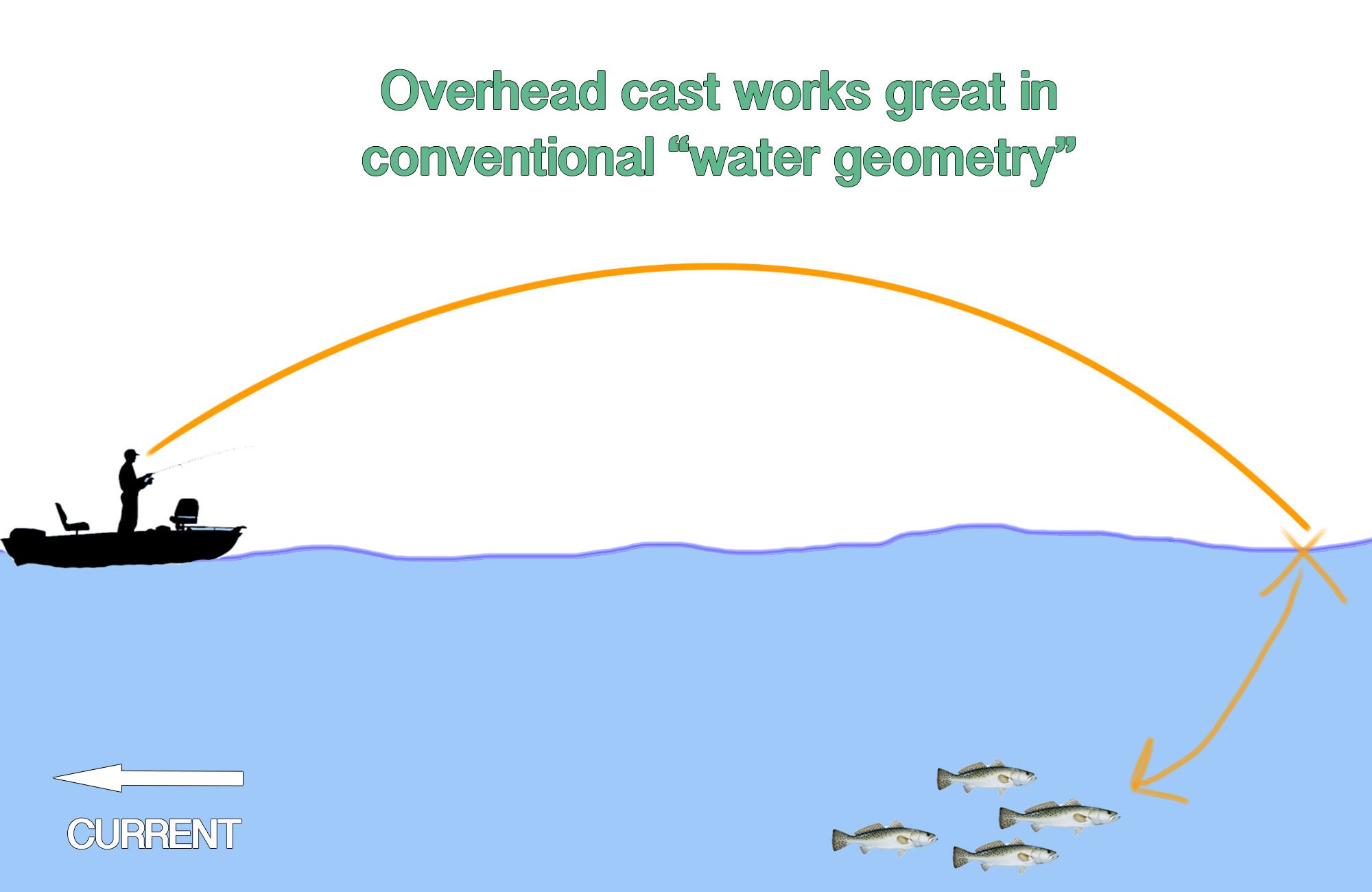
This is what we typically use in the marsh, because there's nothing in the way.
But an overhead cast doesn’t work that well around anything that gets in the way, like a bridge.
If the reasons aren’t obvious, then let me illustrate them for you.
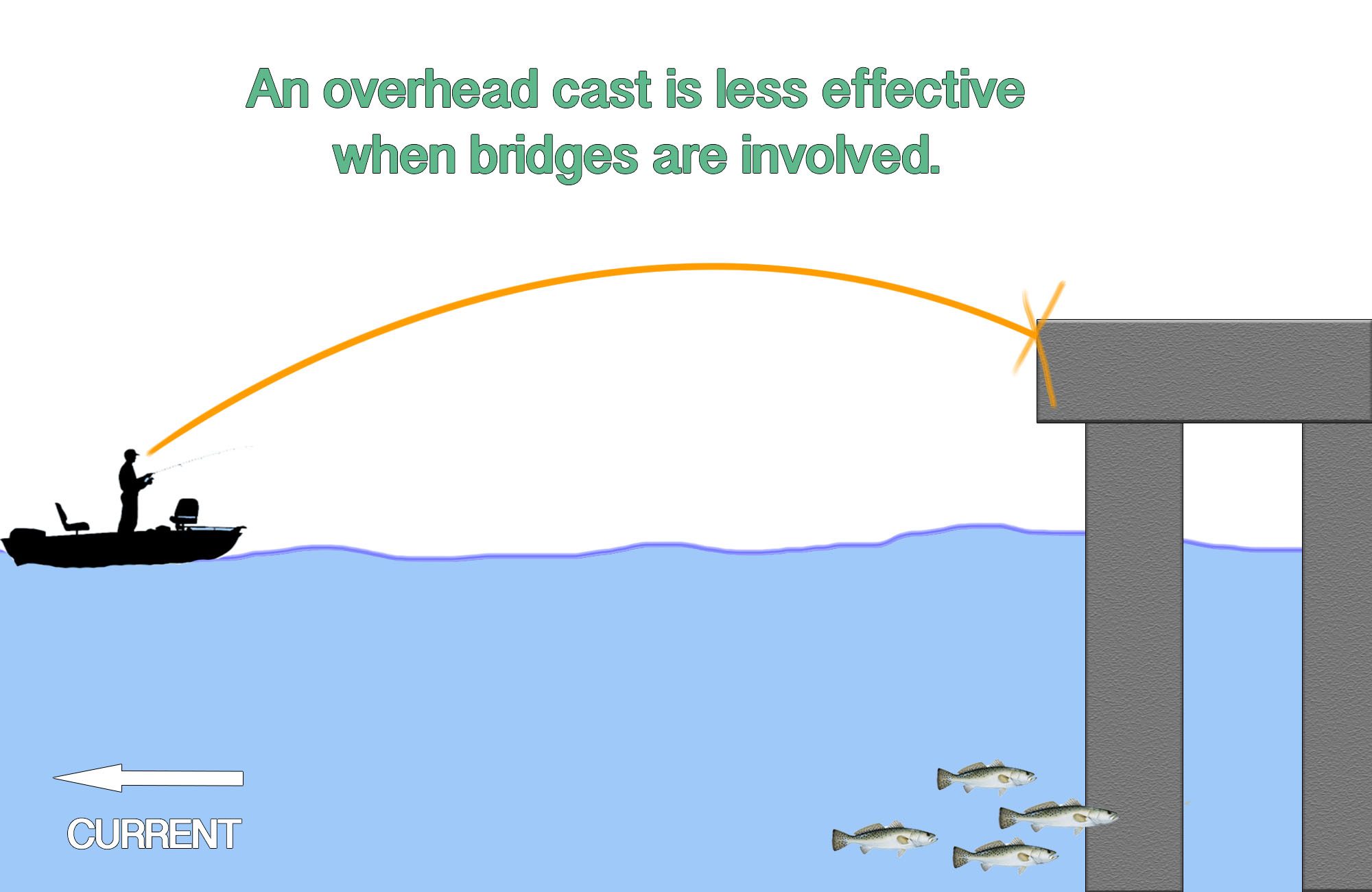
As you can see, the bridge is in the way. This is a different fishing scenario from what we normally encounter in the marsh.
Now, note the current direction in the bottom left hand corner.
Even if you made an accurate overhead cast that placed the lure directly next to the piling, the sinking lure will still get swept away from the fish by the current, like in the doodle below.
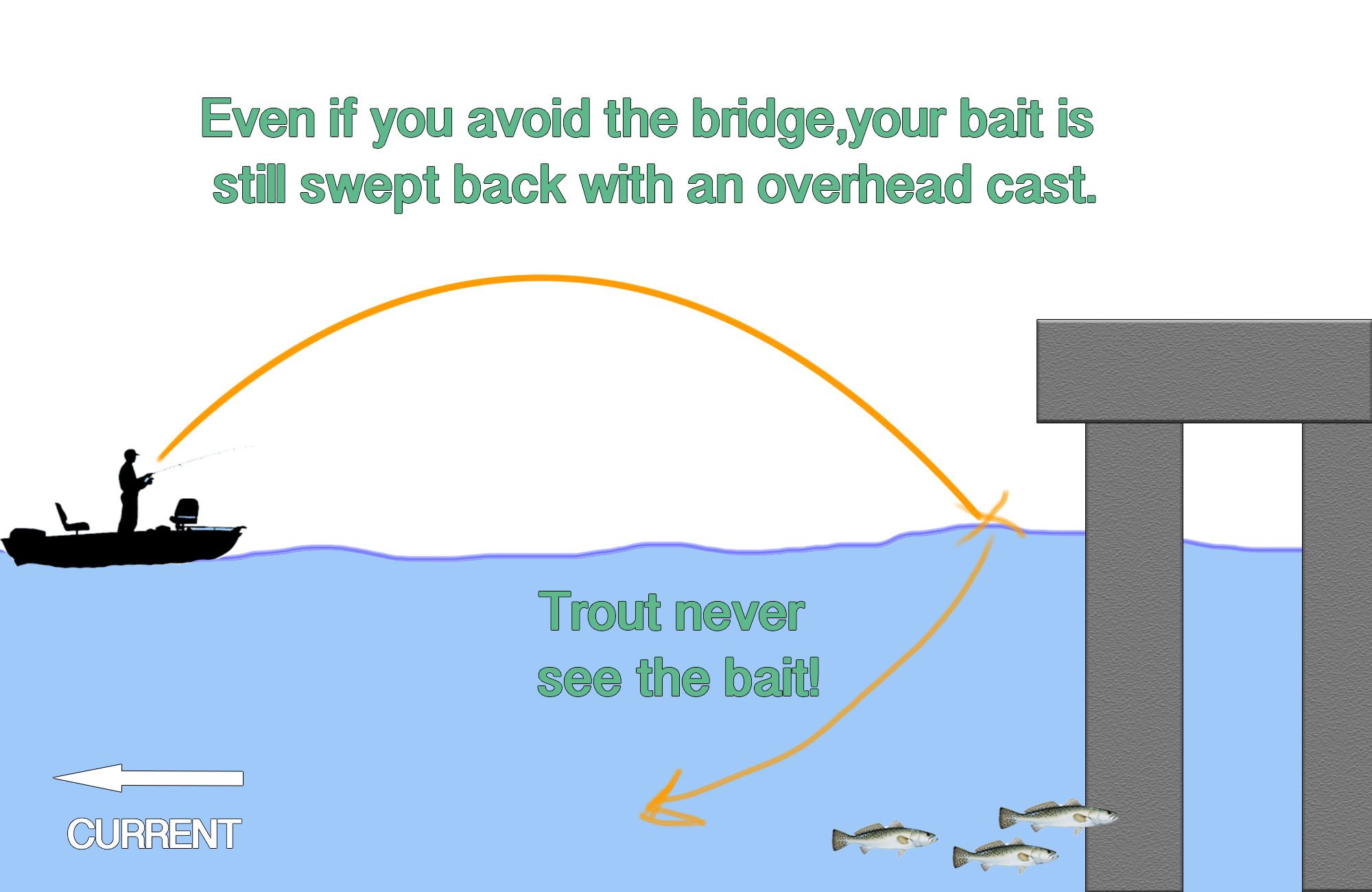
Now, some bridges are really tall and you can more or less get away with the kind of overhead cast you use in the marsh.
But not all of them.
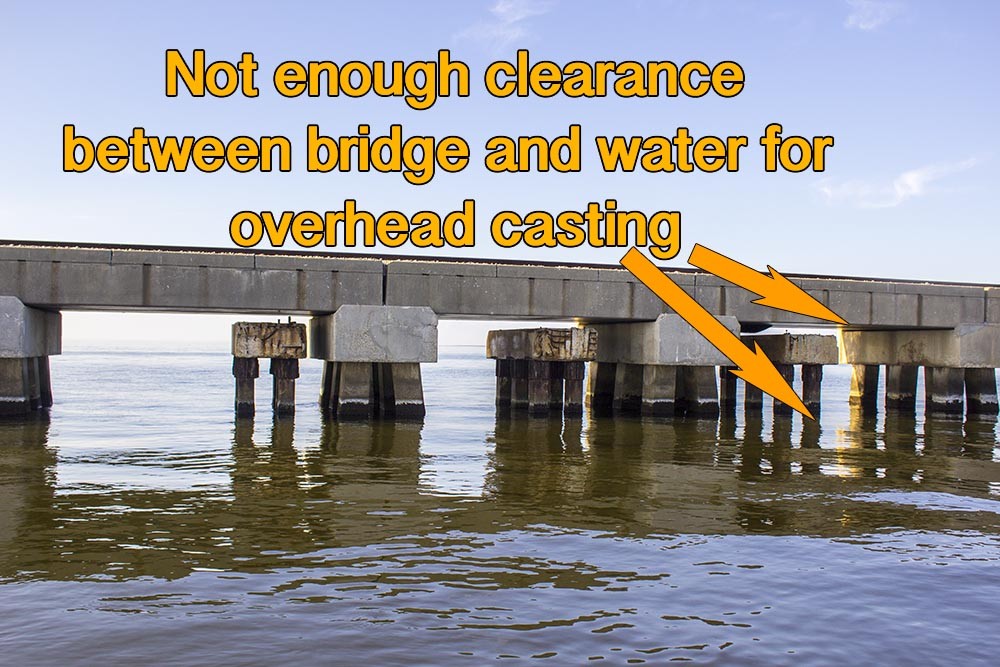
The most productive bridges you can fish in Louisiana have low clearances and cannot accommodate an overhead cast.
The unique structure of a bridge (or dock, natural gas platform, etc.) presents a unique challenge that requires a different casting method.
Roll Casting Works Better For Jigging Speckled Trout
Roll casting is the solution to this challenge.
With a roll cast, you can get under the bridge and give the lure enough “runway” to descend to the speckled trout.
You do this by keeping your rod tip low, off to your side, and "rolling" the rod top to give the lure momentum before releasing your thumb's hold on the spool, sending the lure flying low over the water, with minimal arc, underneath the clearance of a short bridge.
A Quick Disclaimer:
It's not I want to take a moment to mention that roll casting for jigging speckled trout with casting tackle is not the same thing as roll casting in fly fishing.
Obviously. Duh.
But, over the years, I've gotten comments from fly anglers that would lead you to believe that they've copyrighted the term for their own technique, which is something completely different from what you are seeing here.
That's not the case, and you should know that.
Okay, so with that out of the way, let's move on.
As well as I may have explained how to roll cast via text (or not), there is this video below showing how I roll cast when jigging speckled trout.
Note how much lower the lure flies over the water. This really helps on windy days, as roll casting minimizes how much the wind can grab the lure and line.
But Roll Casting is Not Enough!
A roll cast can only get your bait down to the bottom if it flies completely to the other side of the bridge.
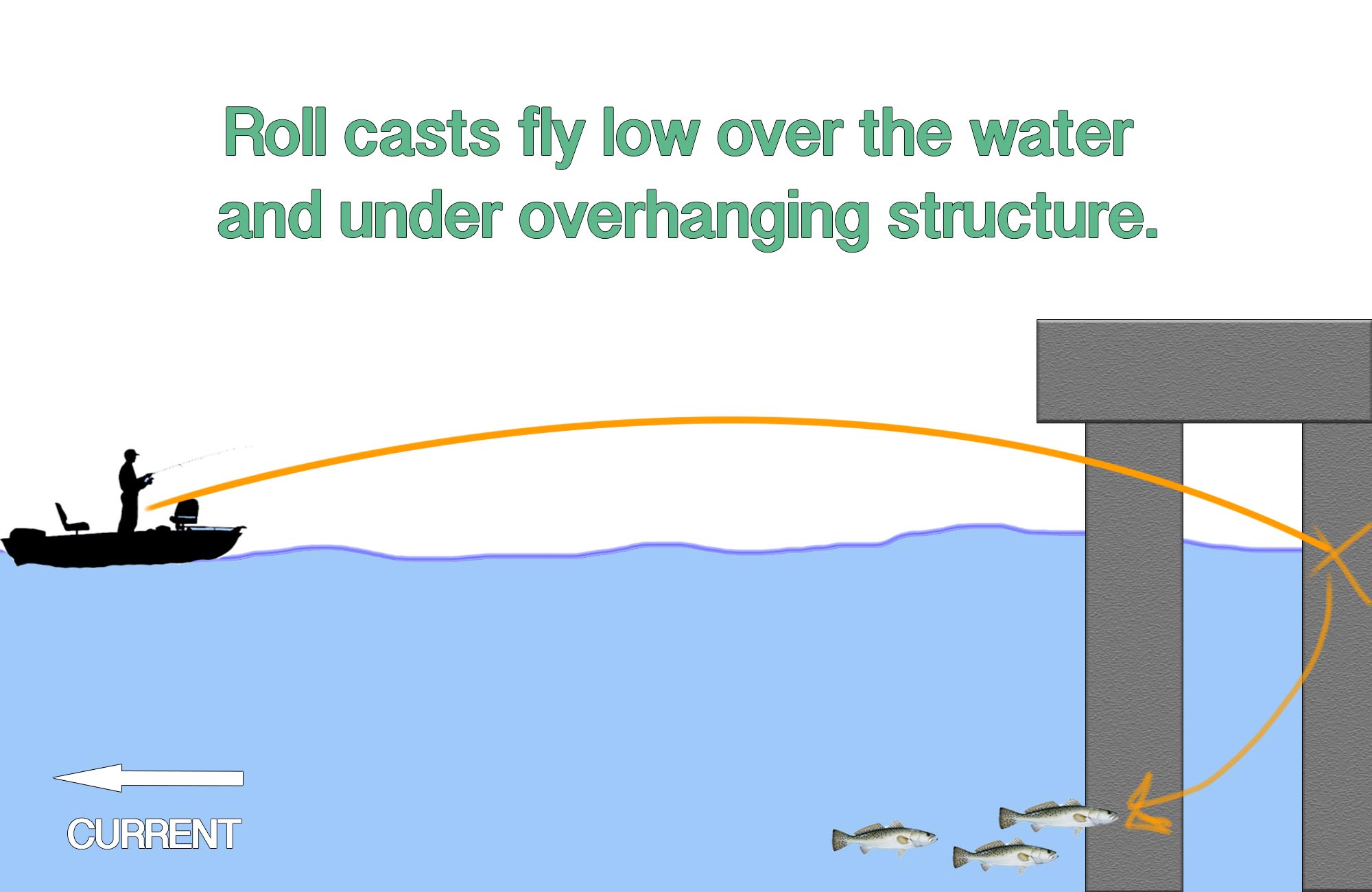
Due to conditions at hand, you cannot always make that perfect roll cast under and across the bridge.
On top of that, trout may be holding to a piling. They do this to get out of strong current rushing between bridge pilings.
When this is the case, you must make super-accurate casts to the piling.
But it gets tougher...
Casting to fish holding tight to structure creates a whole new challenge.
The “runway” the lure needs to get to the bottom went from being 10 feet to ten inches.
Quick Explainer:
A “runway” is the horizontal distance a lure needs in order to travel the vertical distance to the bottom of the water, where feeding trout await.
In the marsh, we have luxurious runways of 10 yards or more. When casting under bridges, we have about 5-10 feet and when casting to fish holding close to pilings, less than a foot.
So, if you cannot adapt to this shorter runway, you will miss fish all day long.
This failure to adapt is the #2 reason people never catch fish: they're not getting their bait in front of the fish where it can be seen and bitten (if you recall, the #1 reason is that they don't find biting fish in the first place).
By now you may be wondering, "How can I adapt to this scenario?"
The solution is to put slack in your line. A lot of it. I'll explain:
Using Slack Line To Jig Speckled Trout
Slack line jigging is a special technique that uses slack intentionally put into fishing line to get a good presentation on speckled trout.
Now, you can pull this extra line out with your hand, and some people do (to include yours truly), but you can also use the inherent design of casting tackle to do it for you in one fluid motion.
Casting reels have the unique ability to continue paying out line even after the lure has stopped moving forward in a cast.
Using this aspect of baitcasters, we can let out more line than is necessary by keeping the spool spinning even after the lure hits the water!
To avoid the dreaded backlash, you simultaneously lift up on the rod and give a little bit of thumb to slow the spool down.
With this advantage you are able to defeat the “short runway” challenge.
You can put enough slack in the line to allow the lure to drop straight down, and not swing on the rod tip, away from the piling.
I’m hoping you’re not confused and that this doodle helps explain the concept more clearly.
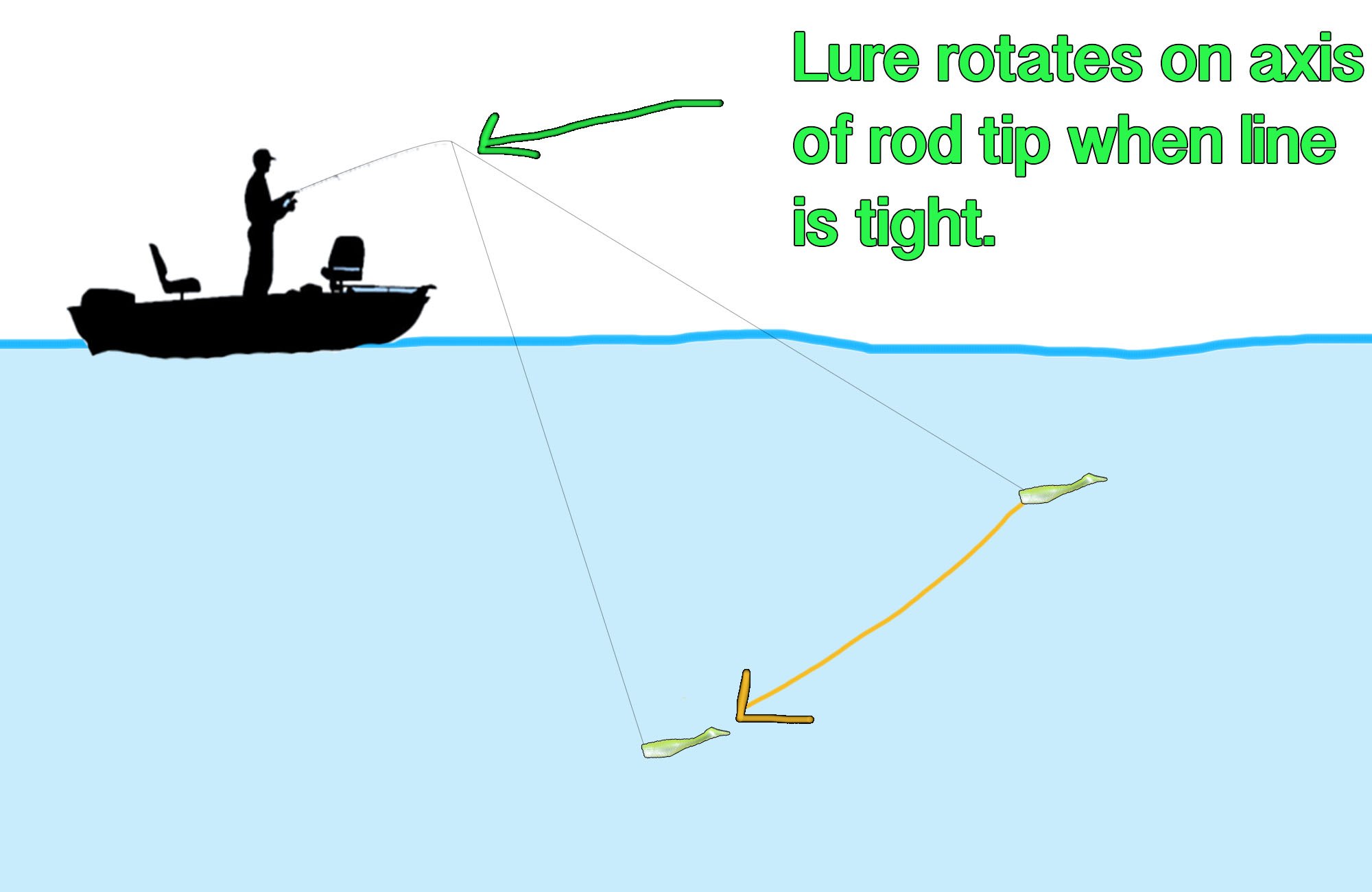
You can see how your lure — on a conventional cast — does not fall straight down. Instead it swings on a tight line, either away from you, towards you, or parallel to you, depending on which way the current is going.
The way to get around this is by breaking the cardinal rule of “keep your line tight”. This is part of how you can succeed in such a unique scenario.
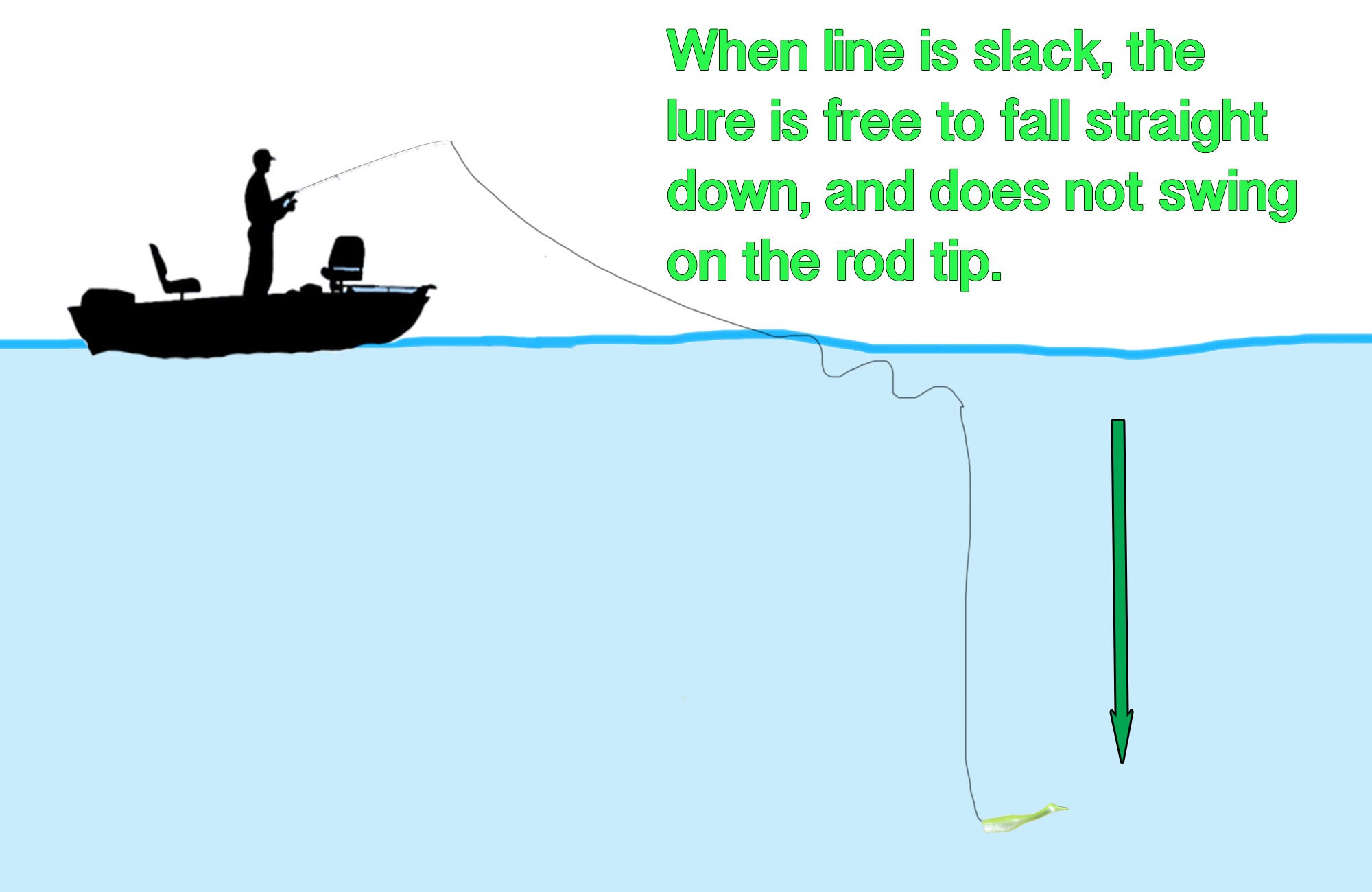
Just to give you some added value, here's a 1 minute clip showing how I put slack in the line while jigging speckled trout from different fishing trips over the years:
Now that you know how to get your lure down there, what do you actually do once it is?
By now you understand why a place like the Trestles is so good to practice jigging speckled trout: it forces you to learn how to put your lure into a desired spot.
This is much different from the blind overhead casting most inshore anglers use in the marsh.
But once your lure sinks to the bottom, what do you do? Let's look at that next.
Did you hit the bottom or is the lure still falling?
The first thing you need to be looking for is if you hit the bottom or not.
This is probably the most critical skill you can learn in this entire guide.
Because, if your lure has not reached the bottom, then the fish down there probably haven't seen it.
If they can't see it, then they can't bite it. It's that simple.
But, if your lure did reach the bottom, then you can begin jigging it.
So how do you know? Let me show you.
The Simple Trick To Knowing If Your Lure Hit The Bottom Or Not
The key is to watch your fishing line beginning at the moment your lure hits the water.
It will remain taut while the lure is falling.
Once the lure hits the bottom, then the fishing line will sag and begin falling itself, especially if it is heavy, like fluorocarbon.
It will look like it suddenly gives out.
Even when there is a little slack you will still see the fishing line relax to some degree.
This is the simple trick to knowing when you're on the bottom and, now that you know your lure is there, you can begin jigging.
It's Time To Begin Jigging
The idea here is that you are going to pick the lure up off the bottom of the water column and let it fall back down.
As you do, the lure will travel horizontally over a stretch of sea floor and hopefully cross paths with a hungry speckled trout.
If not, it will travel back to the boat, you'll reel it in, cast out, and start all over. Rinse and repeat until you catch fish.
But how exactly do you do that? That's what we cover here.
Jig, Jig, Glide
The best way to go about jigging speckled trout is to pump the rod up and down very fast at least two times in a row, then let the lure fall down to the bottom again.
Once you see the line relax, you jig it again. Two quick pumps of the rod.
Rinse and repeat until you catch fish.
That's what I do and that works for me, so here's a couple "cast to catches" of myself demonstrating the technique:
Now, you can jig it once, you can jig it thrice. With practice you will discover what works best for you.
If you ever watch Chas Champagne of Matrix Shad, he uses a pretty quick and furious three-jig technique.
Whether you do it my way or Chas's way, you will learn that this can be pretty tough on your hand and arms.
That's why we use such a light rod and reel to begin with. A heavier rod and reel combo will positively wear you out.
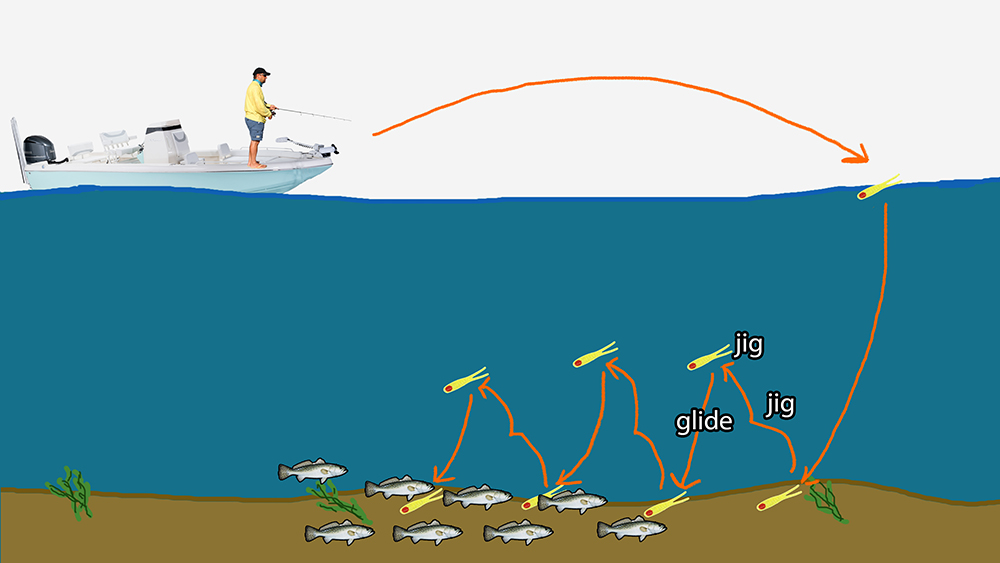
This graphic is crude, but it gives an idea as to how jigging works underwater. Do you see how it covers more ground?
Why not just lift up on the rod? Wouldn't that be easier than strenuous jigging?
Yes, it would be. It would be a lot easier.
It would also not catch as many fish.
Believe me, I've tried. I will do anything to make my life easier out on the water, and experience has revealed that cutting corners on jigging speckled trout doesn't yield better results.
All fish are particular in some way, and one way speckled trout are particular is being attracted to something that stops and starts suddenly and erratically.
They really like to see a lure pop off the seafloor, rather than gently rise from it.
Ultimately, you can experiment to see what works for you but — if you'd like to avoid re-inventing the wheel — just learn how to jig like what you're being shown here.
I know this can all be confusing.
So, if you are confused, or just need better clarification, then please use the comments section below.
I'm always happy when I see people consuming the content created here, and don't mind answering questions when I get time for them.
Plus, it adds value to this guide (for which I thank you).
Otherwise, by now you have a pretty good handle on jigging speckled trout and know what to do.
But you're not done yet! There's more to get right (or risk getting wrong).
Next, we must consider choosing the best jighead, specifically its weight.
Choosing The Correct Jighead Weight
If you've taken my free course Elements of Effective Fishing, then you already have a firm grasp on this, but we will cover sinking weight selection here (to a lesser degree).
If you want to learn more, then I strongly suggest taking that course once you're done with this guide.
Quick sidebar: if you've completed Inshore Fishing 101, then you also took a more in-depth version of Elements of Effective Fishing, as that's included in the "Executing Your Fishing Trip" section of 101.
Anyway, getting back on track: sinking weight is the part of your lure that helps it sink.
The more weight you have, the more it sinks. The less weight, the less it sinks.
This doodle describes what I mean fairly well:
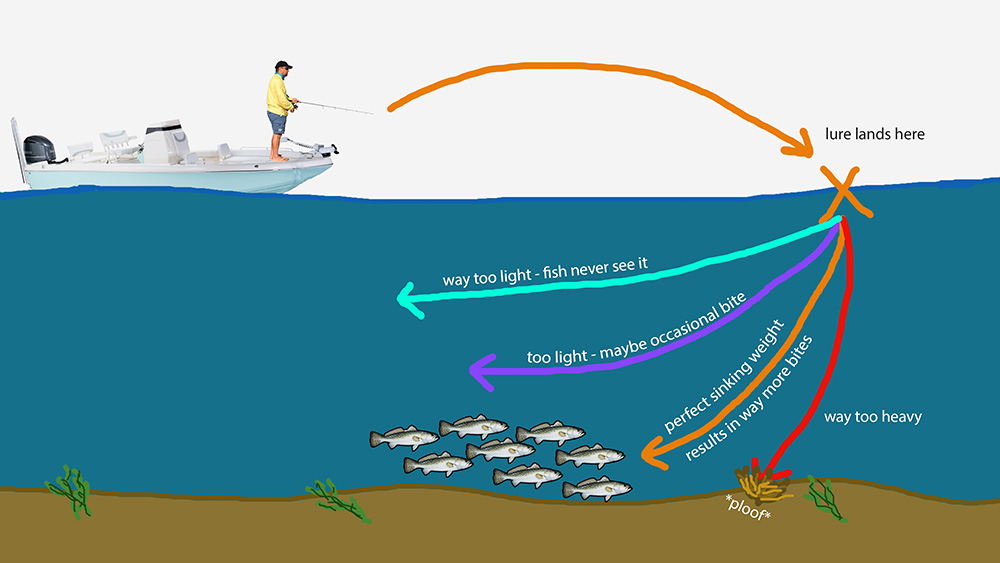
So you can see how you want to select the right sinking weight: if you go too light, your bait will never reach the bottom, but if you go too heavy you will be dragging the bottom and getting snagged a lot.
Plus the bait won't flow naturally with the current.
It's obvious that you want to strike the perfect balance. Here's a cheat sheet to get you by:
Water Depth | jighead Weight |
|---|---|
2 feet or less | 1/8 oz |
2 - 8 feet | 1/4 oz |
6 - 15 feet | 3/8 oz |
10 - 25 feet | 1/2 oz |
25 Feet or more | 3/4 oz+ |
Consider The Heavy Drop Shot
It's worth reiterating that the sinking weight of a jighead is molded onto the hook. The heavier the chunk of lead, the more leverage fish have to spit the hook.
So, if you are fishing water that is so deep and/or fast that you must use sinking weight heavier than a half ounce, then please consider using something that separates the weight from the hook, such as the Heavy Drop Shot.
Now, that cheat sheet is only a general guideline! Current will have a lot to do with weight selection as well.
Since there is no way to practically measure current, all I can say is that the stronger the current, the heavier the jighead you will want to tie on. The slower the current, the lighter the jighead. You get it.
Also, it's worth mentioning that for a place like the Trestles, and most places you would fish inshore on Louisiana's coast, a 3/8oz jighead is pretty standard.
Now that we have slack line and weight selection out of the way, let's move on to the final ingredient that will help you kick ass at jigging speckled trout!
Getting Your Head In The Water
"Getting your head in the water" does not mean literally sticking your head in the water. Sorry to let you down.
Instead, it is a term that describes an angler's ability to visualize what is going on beneath the surface of the water.
Recall that Louisiana's inshore waters are not particularly clear and therefore difficult to see what's going on underwater.
In some places in Louisiana the water can get very clear! But even then it's difficult to clearly ascertain what's happening down there.
So, being able to visualize what is beneath the surface and where your lure and line are is pretty much a superpower when it comes to inshore fishing.
The anglers who can "get their head in the water" have an edge over those who cannot.
From the moment their lure hits the water to the moment it is pulled out to be cast again, they know exactly where their lure is and what it is doing, even though they cannot see it.
Inside their mind, they picture its location in the water column and know where it is in relation to everything else in the water, such as bridge pilings and especially the fish.
Most anglers just see the surface of the water, make a cast, and have no idea where the lure is once it slips out of sight.
Do you see the difference?
It Will Come With Experience & Deliberate Practice
The ability to effectively throw a jig and "get your head in the water" is not something that arrives after a fishing trip or two.
It takes time and experience jigging speckled trout. There is no shortcut around this.
Simply being on the water isn't enough; deliberate practice is a requirement. You must come out of your comfort zone, it is the only way to get better.
No, this is not as fun as drinking beer and grab-assing with your frat buddies while attempting to fish. Sorry. If that offends you then you must be on the wrong website.
So, I am telling you — with the greatest conviction in my heart — that gaining the skill of visualizing what's underwater and, by extension, jigging speckled trout, is worth the time and effort that you would have put into it.
Jigging Speckled Trout Lagniappe
In Louisiana, "lagniappe" is a term that describes "a little extra". It was a few extra things I though of while writing this guide, so I put them here for your convenience.
They are:
- breaking in your hand
- jigging shallow water
- a bite on slack line
- how to hold the baitcaster
- using hi-viz line
- balanced is better
- jighead weight consistency
- foot pedal trolling motors
Some of these are splitting hairs, others are more practical, but I'll detail each one just so you're warm and fuzzy.
You May "Break In" Your Hand
If you are new to casting tackle, then know that holding a casting reel and jigging it all day will probably cause some amount of discomfort at first.
The good news: you will get used to it.
With time and experience, your hand will "break in" from what it was probably used to before — holding a spinning combo — and adapt to holding what's going to catch a bunch more speckled trout: holding a baitcaster.
What about jigging shallow water?
I'm usually going to throw something else for shallow water, like a popping cork or suspending bait.
But there are times I have thrown a jig shallow and that's easily adapted to by using a light jighead, such as 1/8 oz or even a flutter hook as light as 1/16 oz.
Beware: your casting game had better be on point. Casting lures that light can be tough.
But it can be rewarding! Especially when casting too the shallow edge of rock piles, with the Fourchon Barges and Long Rocks out of Hopedale being a great example.
If you're interested, this guide details how I fish the Long Rocks to catch limits of speckled trout.
What if the trout bites while there is slack in the line?
This is where all the parts of this guide really come together to solve an issue that could possibly arise while jigging speckled trout: what if the fish bites the lure when there's a bunch of slack in the line?
Such a scenario is why you must have your "head in the water", because you'll know if the lure is down there yet and if it is likely to be bitten (or not).
But sometimes this happens anyway and you have to set the hook by quickly taking in slack with the reel and swinging the rod as hard and wide as you can in order to get the line tight and achieve a good hookset.
Now it's apparent why you want that super fast 8:1 gear ratio and super fast rod tip: both take up slack way better.
Also consider this: if your lure is consistently bitten before it hits the bottom, then you'll know fish are feeding higher in the water column and remedy the situation by not adding so much slack to the line (if any at all).
This is how you "listen to what the fish are telling you" and adjust accordingly.
How To Hold Your Baitcaster
It seems like you would want to hold your baitcaster any which way is good for you and, at the end of the day, that isn't exactly wrong.
Most people do something that looks like this:
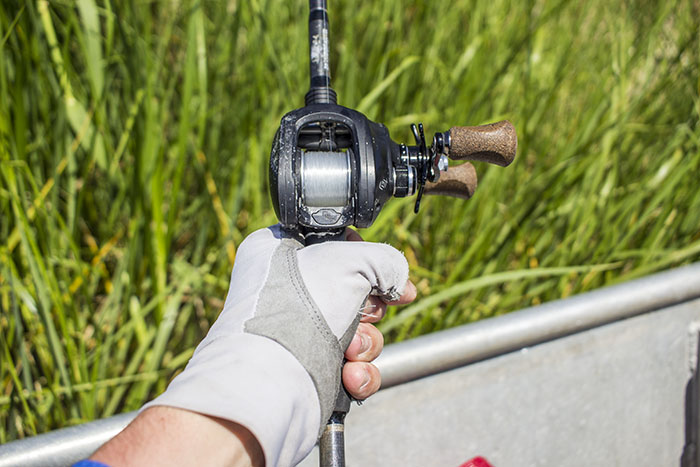
If that works for you, then that's okay and you will get by for awhile.
But I am kind of religious about this and feel that the correct/best way is to hold the entire reel in the palm of your hand, like in the picture below:
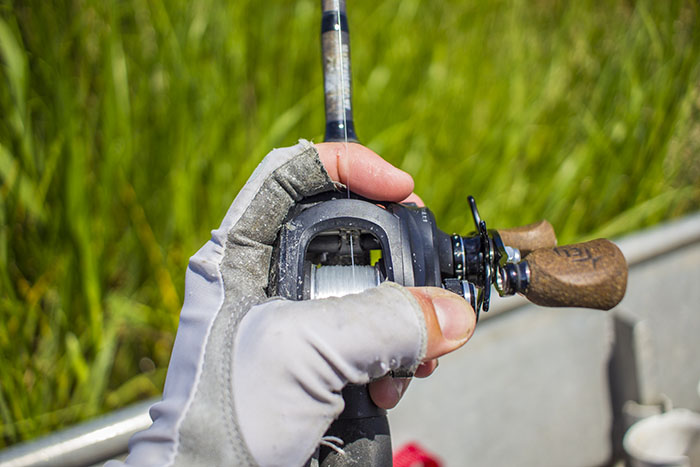
The reason why is that it places the bulk of the combo's weight in your hand, rather than just ahead of it.
This makes the rigors of jigging speckled trout much easier on your hand, wrist and elbow. Trust me on this. It's very embarrassing explaining how you got tennis elbow from fishing.
I've done it and feel that this method of holding a baitcasting reel will help you avoid that experience.
But there's more!
You want to hold the reel in your palm so the fishing line rides over your index finger.
Scroll up and look at that picture again. You will see the fishing line coming off the spool onto the finger.
This makes you that much more sensitive to tiny bites from speckled trout.
Think about it: that line is running directly from your finger to the mouth of the fish. There's no need to rely only on the rod being sensitive enough to transmit the bite.
The strike will go straight to your finger like an electric shock.
This is key to boating more fish, especially if you're going off feel alone.
With that said, if you really are interested in becoming proficient at jigging speckled trout, then you should not rely upon the feel of the bite alone.
You should use a visual indicator, which can be more telling than the tactile kind.
This leads us to our next bit of lagniappe:
Using Highly Visible Fishing Line For Jigging Speckled Trout
Sometimes bites are so subtle that you will see them first, and the place to see this happen is where your fishing line intersects the water's surface.
Having good eyesight certainly helps, but what else helps even more is having a highly visual line.
The best fishing line for this is Stren's Fluorescent Blue Monofilament Fishing Line. It's bright blue above the surface of the water, but remains clear beneath the surface.
The monofilament fishing line sold by Matrix Shad is pretty much the same thing.
Next up is a balanced combo.
Being Balanced Is Better Than Being Lighter
As much as I've made the case for having a light casting combo, experience has shown me that having something that is balanced is better.
What I mean by that is a casting rod/reel combo that is balanced in your hand, with the center of gravity being in your hand, and not so much at either end of the rod.
This makes the actual jigging motion of the combo much easier on your hands, wrist and elbow.
I bring this up because I am something of a nerd, and have taken to weighing out rods, reels, etc. to see how much lighter (or not) some tackle is over other tackle.
And what I've learned is that some combos may weigh less, but are more exhausting to fish with because they are heavier toward the tip of the rod, rather than at the palm.
Other combos are heavier but jig a lot easier because they are balanced.
A great example would be that Daiwa Tatula combo. A Daiwa Tatula 80 and their Tatula 6'3" casting rod is very balanced, but weigh more than other combos I have.
I don't have a way for you to measure this. I'm just putting it out there so you're aware of it.
In the future, when I can come up with a practical method to measure balance, I will return and update this guide.
And, if you're subscribed to my newsletter, then you will know when it happens.
Anyway, since I mentioned that I don't have much of a personal life and resort to weighing random fishing tackle to fulfill my psychological needs, let me bring up the next bit of lagniappe concerning jigheads:
Jighead Weight Consistency
All jigheads are labeled according to their weight.
Go to any lure manufacturer's website and you'll see them ordered by weight, usually something like 1/8 oz, 1/4 oz, 3/8 oz, 1/2 oz and so on.
Now, if you were to take jigheads (i.e. 1/2 oz jigheads) from the same manufacturer's batch and weigh them, then you would most likely find that they are not exactly 0.5 oz on the scale.
This is okay so long as they are all identical or nearly identical in weight.
But, if you were to take 1/2 oz jigheads from different manufacturers and weight them, then you would find that they probably aren't the same weight, like in the picture below.
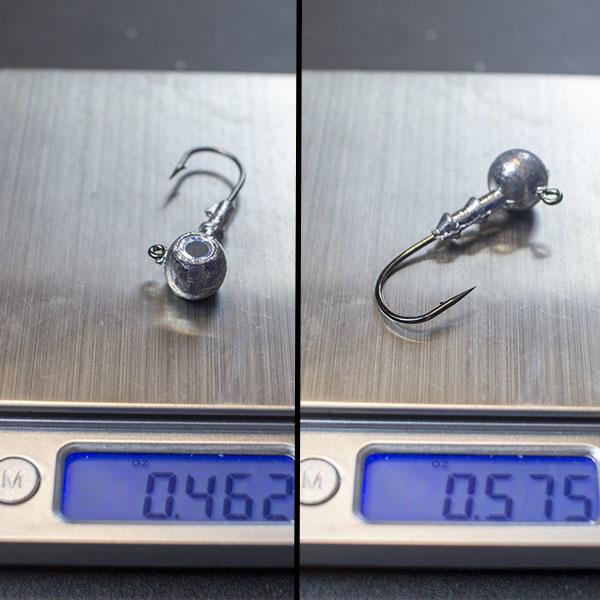
Both are advertised as being a half ounce, but they are slightly different and knowing that is key to achieve consistent presentations.
This is a small problem.
It's not a deal breaker, nor is it anything earth shattering that will ruin your fishing trip, but something to consider.
One jighead weighs more than the other, therefore changing how your lure sinks through the water column and changing your presentations of the lure to the fish.
This isn't something to go wild over, it's just something to consider, especially if you are learning to "get your head in the water".
The prudent thing to do here is to ensure you are keeping your jigheads organized and separated. I don't mix jigheads from different manufacturers. I keep them separated and you should, too.
Now that we've knocked that out, let's move on to our last bit of lagniappe:
Foot Pedal Trolling Motors
I've fished the Trestles (aka The Dojo of Jigging Speckled Trout) in bay boats, flat boats, flats boats, and bass boats and hands down the bass boat with a cable-steered foot pedal trolling motor is the best.
You should really consider the virtues of a foot pedal trolling motor for jigging speckled trout. It gives you more power and control over the boat, and leaves your hands where they belong: on the fishing rod.
People love to argue about this on social media, but those same people fail to show the fishing reports to back up their claims. Their pride would be hurt at a place like the Trestles.
If you want to learn more about my argument for foot pedal trolling motors, then please check out this video guide here.
Also, if you're curious as to why I fish out of a bass boat, then I wrote this article here explaining why.
But what if I don't run a foot pedal trolling motor?
Then do not go out and buy one.
Instead, use what you have to the best of your abilities. That kind of attitude trumps equipment every day of the year, and that's the attitude I had for years and still have today, and it has caught me a lot of fish.
If you're not sure, then consider one of Louisiana's jigging speckled trout expert (arguably the expert) uses a hand tiller trolling motor.
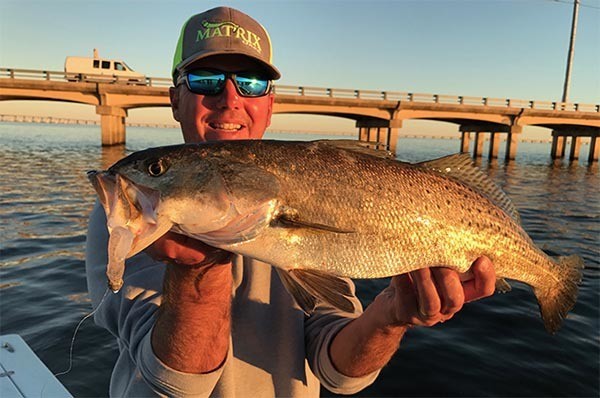
If you've ever seen his videos then you've seen him expertly working that tiller handle. He's had a lot of experience and he catches a lot of speckled trout.
I would be reluctant to pick a jigging battle with Chas because he will most likely skull drag me across Lake Pontchartrain. Ha ha!
So...Experience > Equipment
With all that said, jigging speckled trout does not require any specific kind of trolling motor or, arguably, no trolling motor at all.
Jigging Speckled Trout Is An Excellent Technique To Use Across Louisiana's Coast
I'll tell you that jigging speckled trout is something you really only see being done in Lake Pontchartrain, especially on her bridges.
If you go to other parts of Louisiana, or even the rest of the Gulf Coast and Eastern Seaboard, you are not going to see inshore anglers employing the same tackle and technique described in this guide.
Which is too bad for them, because jigging speckled trout in the way described here is a powerful technique that gives any angler an advantage in more places than one.
Just because jigging is more popular in Lake Pontchartrain doesn't mean that it does not work outside of Lake Pontchartrain.
I have taken the skills and knowledge taught here to the rest of Louisiana's coast and enjoyed much success.
That's because I was able to target speckled trout that were otherwise un-targetable with conventional methods that everyone else was using (usually a popping cork or Carolina rig).
This includes places like east and west of the Mississippi River, such as: Venice, Grand Isle, Port Fourchon, Vermillion Bay, Hopedale, Delacroix, Reggio, Cocodrie and more.
What you found here is advanced fishing knowledge. Not everyone knows it, not even most fishing guides.
That's right. I said it. Not even most fishing guides know how to get presentations on speckled trout using what I've laid out in this guide.
The story below details such an example:
Slidell vs Dulac: A Story About Jigging Speckled Trout
This real-life story that actually happened serves to illustrate the point I am making here, and I will leave out names so no one has any shade cast upon them.
Some time ago, there were a couple guides out of Slidell (a popular launching point to fish Lake Pontchartrain and her bridges, in case you were not aware) who became acquainted with another guide out of Dulac (which is a highly productive and renowned coastal area south of Houma, there is great fishing there) through a common sponsor.
All three of these guides were experienced, well known and had great reputations for putting their customers on fish, even though they did so in areas distant from each other that set up a lot differently.
Lake Pontchartrain's bridges are exposed to wind and challenging to fish, for the reasons described earlier in this article.
Dulac's marsh is protected from most wind and has no obstructions to casting.
The Slidell guides and Dulac guide took to each other and became good friends before eventually agreeing to go fishing together in Lake Pontchartrain.
It was a good day to fish The Trestles, and the Slidell guides had casting tackle with 3/8 oz jigheads tied on.
The Dulac guide showed up with the tackle he commonly used successfully where he fished: a double-rig with two 1/8 oz jigheads.
Now, given everything you learned, what do you think happened?
The Dulac guide didn't see anything wrong with his tackle. He had a lot of (misplaced) confidence in it.
This confidence withered when he proceeded to not catch a damn thing while he watched the two Slidell guides flip one speckled trout after another into the boat.
He got to learn the hard way about weight selection, slack line fishing, "getting your head in the water" and all the other things detailed above.
Eventually he warmed up to what the Slidell guides had to share and he started catching fish, too. Everyone had fun and it was a great time.
Now, you could say that the roles would be reversed if they fished in Dulac, and that would be somewhat true. Yes, the Dulac guide knows Dulac much better than the Slidell guides because that's where he fishes on a regular basis.
But the difference is that the Slidell guides would be able to match the Dulac guide's technique without the steep learning curve.
Throwing a Double Rig (popping cork, or whatever "conventional" tackle) is not difficult. It's an "idiot bait". All you have to do is cast and retrieve. Not hard.
But jigging speckled trout is a different animal that requires a degree of skill, knowledge, deliberate practice and experience to effectively use.
Here's the fact of the matter: those Slidell guides (if given enough time) could find and catch Dulac speckled trout using a jig that the Dulac guide had no idea were there.
There's a similar story I heard about a Lake Pontchartrain angler (who was proficient at jigging speckled trout) going to coastal Texas to wade the flats there.
But, after he and his Texas friends didn't have much success in shallow water, he inquired about a bridge they had seen in the area.
His Texas friends objected, saying they never catch anything there, it would be a waste of time, blah blah blah.
Well, our intrepid jig enthusiast talked them into it and they caught 40 speckled trout by jigging those bridge pilings. That's a great trip unlocked using the same knowledge you have learned here.
So this is the point I'm trying to make about jigging speckled trout...
A few bridges in Lake Pontchartrain are great places to practice and learn, but they are not the only locations you can catch speckled trout with a good jigging technique.
In fact, you'd be crazy not to have your jigging rod ready to go on every fishing trip you go on. It really is a special technique that shines every season of the year and works in many places to include, but not limited to:
Anywhere there's something obstructing an overhead cast, preventing anglers with conventional tackle to catch fish at that location, that's where you want to be jigging speckled trout.
Anywhere the conditions are good and you can "get your head in the water" and visualize where that jig needs to go, is where you need to be casting one.
Tell me, what do you think about jigging speckled trout?
I value feedback from inshore anglers who are willing to commit themselves to this great pursuit (the pursuit of speckled trout, that is).
And anyone who can get through a large guide like this probably has a little more focus and mettle than most.
I could certainly get a slew of less-thoughtful, four-word sentences on social media (or maybe just four-letter words), but something in this format of a 10,000+ word article is surely going to be more meaningful.
So, if you have something to add, a question, a disagreement — or simply a relatable fishing experience — then please use the comments section below.
When I get time, I'll be sure to check and reply.
Thank you for taking time to visit my blog!

Neil, please use this technique anywhere you can visualize putting a jig. I’ve used it a bunch on the artificial reefs of Mississippi Sound, as well as the rigs in Lake Borgne and Chandeleur Sound. It’s a great technique for targeting speckled trout and I hope you enjoy the same amount of success with it as I have.
Tight lines, and thanks for visiting my site!
I’ve jigged with braid and just do not enjoy it nearly as much as monofilament. Braid is a great tool and it has its place in my boat, just not jigging speckled trout on Louisiana’s coast. lol
Thank you so much for reading this guide and taking time to comment, I really appreciate that!
That’s very interesting, Jon.
Speckled trout definitely like that kind of presentation. Same thing for topwater lures. I can be on a great topwater bite and throw a Whopper Plopper only to get no bites. But as soon as I go back to something that’s walked (like a Top Dog Jr.) then the bite is back on.
You may be on to something!
Thanks for visiting my website!
You’re welcome, thank you for visiting!
I’m glad to hear that! It’s much easier for me to make content like this rather than make videos. I do enjoy the videos, but once they’re done, that’s it. These guides I can update and make more useful with multimedia content in a way that video just doesn’t quite fulfill.
So, I’m glad you’ve taken time to visit my website. I really do my best to keep it simple and keep it ad-free.
Thank you, Jerome!
Hey Jacob, thank you for taking time to comment. I really appreciate that. It’s hard to get folks off of social media, so it’s great you made time to come here and, of course, for joining LAFB Elite.
The Inshore Fishing 201 you took (well, I assume so anyway) is good, but I plan to overhaul it like I did Inshore Fishing 101.
So, stay tuned for that. Thank you for visiting LAFB!
Great article, Devin! I am just learning to fish the bridges in Lake P. and will be putting this to work this weekend! I just put on braid b/c so many people talk about how much more sensitive it is. But, after reading this and fishing braid last weekend, I am ready to go back to Mono. The big difference is that I can’t see the braid in the water making it harder to know when the lure hits bottom.
Thanks for a great article!!
Thanks for another great article and although I don’t fish in Lake Pontchartrain, I’ll be trying to perfect this technique on the bridges in Mississippi.
Great article! I have avoided casting tackle most of my life after failed attempts as a teenager with crappy reels. After your courses I decided to give it a shot again and I have found the bridges an excellent place to hone my skills and become more proficient. There is a ton of realestate to drift and make cast after cast at a specific aiming point (pilings) and I have a lot betting chance of catching something than practicing in the yard lol.
Ive watched all your videos and read all your articles and this is the best one yet.
Fantastic info for free! Really enjoyed reading this.
Thanks for this Devin, you are the man!
Great article, Devin! You mentioned that the ‘Pontchartrain pop’ style of retrieve works for speckled trout because they respond best to that sudden motion. I think I may know why. I live on the water in Eden Isle and have spent a lot of time watching white shrimp cruise around my dock lights at night among trout, redfish, largemouth bass and other predators. I’ve observed that a single fish almost NEVER catches a shrimp on the first attempt – the long antennae warn the shrimp of ‘incoming’ trouble and they are able to take evasive action, which works 99.9% of the time. The shrimp DO often get caught, but only after they ricochet around a few times to avoid that first fish, and the second, third, or fourth – only to land right in front of a trout, usually NOT the one they just escaped from. Bass and redfish are chasers, who will zoom around the dock in pursuit of the shrimp – but trout are school fish, and seem to know that one of their schoolmates may scare up an easy meal for them – but only if they are tuned-in to attack when a shrimp suddenly appears in front of them. This may explain their response to popping a jig off bottom – even when their forage is not shrimp, they seem programmed to maintain an attack response to rapid, sudden movements…
You’re welcome. And THANK YOU for visiting!
It is a long guide, but I hope you can make time to get through it soon. Jigging speckled trout really is such a fun and productive technique to catch them.
Thank you for making time for my website and I hope you come back soon.
SeaBrook is one of the places I had in mind when thinking of fishing the Heavy Drop Shot, or anything heavier than a 1/2oz of sinking weight. The Mississippi River in Venice, too (when she’s low of course).
Thank you for commenting!
At Seabrook we tie on jigheads three quarters of an ounce.
We also fish with a Rucker Rig which is like a carolina rig with a big bank sinker instead of an egg sinker,
Your readers shuld try that.
Great blog, thanks for writing it!
– Dave
its a long read, but i’ve bookmarked it for later
for what it’s worth, i really like to use bright white or glow colors
if the water is dirty, a dark purple is good
also, it don’t hurt to tip wit dead shrimp when the trout got lockjaw
very good article you made here, thank u
This is GREAT! I cannot believe you put this much work into it. GREAT work, Captain Devin! Thank you so much!